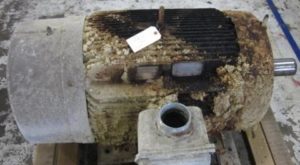 The five whys refers to the practice of asking five times why a motor failure occurred in order to get closer to the root cause of the problem. Failure to determine the root cause can result in treating the symptoms of the problem instead of its cause, in which case you will continue to have the same problems over and over again.
The five whys refers to the practice of asking five times why a motor failure occurred in order to get closer to the root cause of the problem. Failure to determine the root cause can result in treating the symptoms of the problem instead of its cause, in which case you will continue to have the same problems over and over again.
- Why did the motor fail? It shorted to ground.
- Why did it short to ground? The ground wall insulation failed.
- Why did the ground wall insulation fail? The insulation overheated.
- Why did the insulation overheat? Excessive ambient temperature.
- Why was the ambient temperature so high? The cooling fan motor was not operating correctly.
Just replacing the motor would not solve the cooling fan problem and the new motor would be in the same high risk environment.


 Decatur Industrial Electric is regularly scheduled at a customer site to inspect and maintain their equipment to ensure optimal performance. Our routine inspections help reduce unexpected downtime and extend equipment life.
Decatur Industrial Electric is regularly scheduled at a customer site to inspect and maintain their equipment to ensure optimal performance. Our routine inspections help reduce unexpected downtime and extend equipment life.